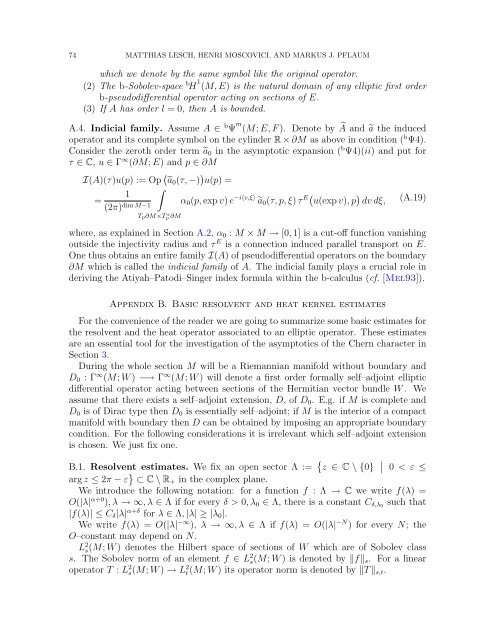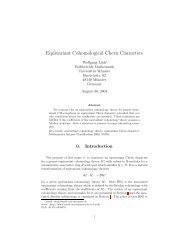Connes-Chern Character for Manifolds with Boundary and ETA ...
Connes-Chern Character for Manifolds with Boundary and ETA ...
Connes-Chern Character for Manifolds with Boundary and ETA ...
You also want an ePaper? Increase the reach of your titles
YUMPU automatically turns print PDFs into web optimized ePapers that Google loves.
74 MATTHIAS LESCH, HENRI MOSCOVICI, AND MARKUS J. PFLAUM<br />
which we denote by the same symbol like the original operator.<br />
(2) The b-Sobolev-space b H 1 (M, E) is the natural domain of any elliptic first order<br />
b-pseudodifferential operator acting on sections of E.<br />
(3) If A has order l = 0, then A is bounded.<br />
A.4. Indicial family. Assume A ∈ b Ψ m (M; E, F ). Denote by à <strong>and</strong> ã the induced<br />
operator <strong>and</strong> its complete symbol on the cylinder R × ∂M as above in condition ( b Ψ4).<br />
Consider the zeroth order term ã 0 in the asymptotic expansion ( b Ψ4)(ii) <strong>and</strong> put <strong>for</strong><br />
τ ∈ C, u ∈ Γ ∞ (∂M; E) <strong>and</strong> p ∈ ∂M<br />
I(A)(τ)u(p) := Op ( ã 0 (τ, −) ) u(p) =<br />
∫<br />
1<br />
=<br />
(2π)<br />
dim M−1<br />
T p∂M×T ∗ p ∂M<br />
α 0 (p, exp v) e −i〈v,ξ〉 ã 0 (τ, p, ξ) τ E( u(exp v), p ) dv dξ,<br />
(A.19)<br />
where, as explained in Section A.2, α 0 : M × M → [0, 1] is a cut-off function vanishing<br />
outside the injectivity radius <strong>and</strong> τ E is a connection induced parallel transport on E.<br />
One thus obtains an entire family I(A) of pseudodifferential operators on the boundary<br />
∂M which is called the indicial family of A. The indicial family plays a crucial role in<br />
deriving the Atiyah–Patodi–Singer index <strong>for</strong>mula <strong>with</strong>in the b-calculus (cf. [Mel93]).<br />
Appendix B. Basic resolvent <strong>and</strong> heat kernel estimates<br />
For the convenience of the reader we are going to summarize some basic estimates <strong>for</strong><br />
the resolvent <strong>and</strong> the heat operator associated to an elliptic operator. These estimates<br />
are an essential tool <strong>for</strong> the investigation of the asymptotics of the <strong>Chern</strong> character in<br />
Section 3.<br />
During the whole section M will be a Riemannian manifold <strong>with</strong>out boundary <strong>and</strong><br />
D 0 : Γ ∞ (M; W ) −→ Γ ∞ (M; W ) will denote a first order <strong>for</strong>mally self–adjoint elliptic<br />
differential operator acting between sections of the Hermitian vector bundle W . We<br />
assume that there exists a self–adjoint extension, D, of D 0 . E.g. if M is complete <strong>and</strong><br />
D 0 is of Dirac type then D 0 is essentially self–adjoint; if M is the interior of a compact<br />
manifold <strong>with</strong> boundary then D can be obtained by imposing an appropriate boundary<br />
condition. For the following considerations it is irrelevant which self–adjoint extension<br />
is chosen. We just fix one.<br />
B.1. Resolvent estimates. We fix an open sector Λ := { z ∈ C \ {0} ∣ 0 < ε ≤<br />
arg z ≤ 2π − ε } ⊂ C \ R + in the complex plane.<br />
We introduce the following notation: <strong>for</strong> a function f : Λ → C we write f(λ) =<br />
O(|λ| α+0 ), λ → ∞, λ ∈ Λ if <strong>for</strong> every δ > 0, λ 0 ∈ Λ, there is a constant C δ,λ0 such that<br />
|f(λ)| ≤ C δ |λ| α+δ <strong>for</strong> λ ∈ Λ, |λ| ≥ |λ 0 |.<br />
We write f(λ) = O(|λ| −∞ ), λ → ∞, λ ∈ Λ if f(λ) = O(|λ| −N ) <strong>for</strong> every N; the<br />
O–constant may depend on N.<br />
L 2 s(M; W ) denotes the Hilbert space of sections of W which are of Sobolev class<br />
s. The Sobolev norm of an element f ∈ L 2 s(M; W ) is denoted by ‖f‖ s . For a linear<br />
operator T : L 2 s(M; W ) → L 2 t (M; W ) its operator norm is denoted by ‖T ‖ s,t .

















